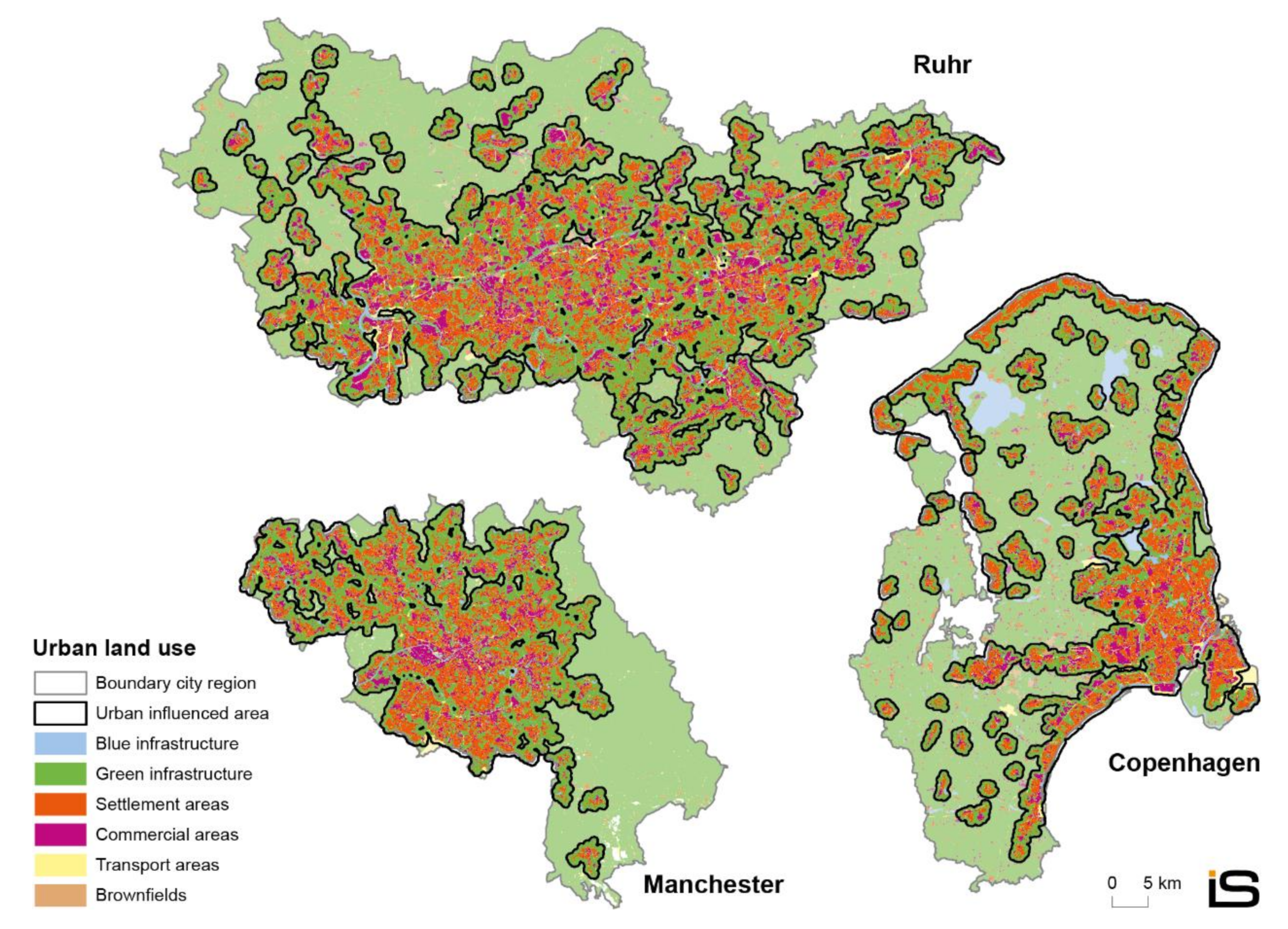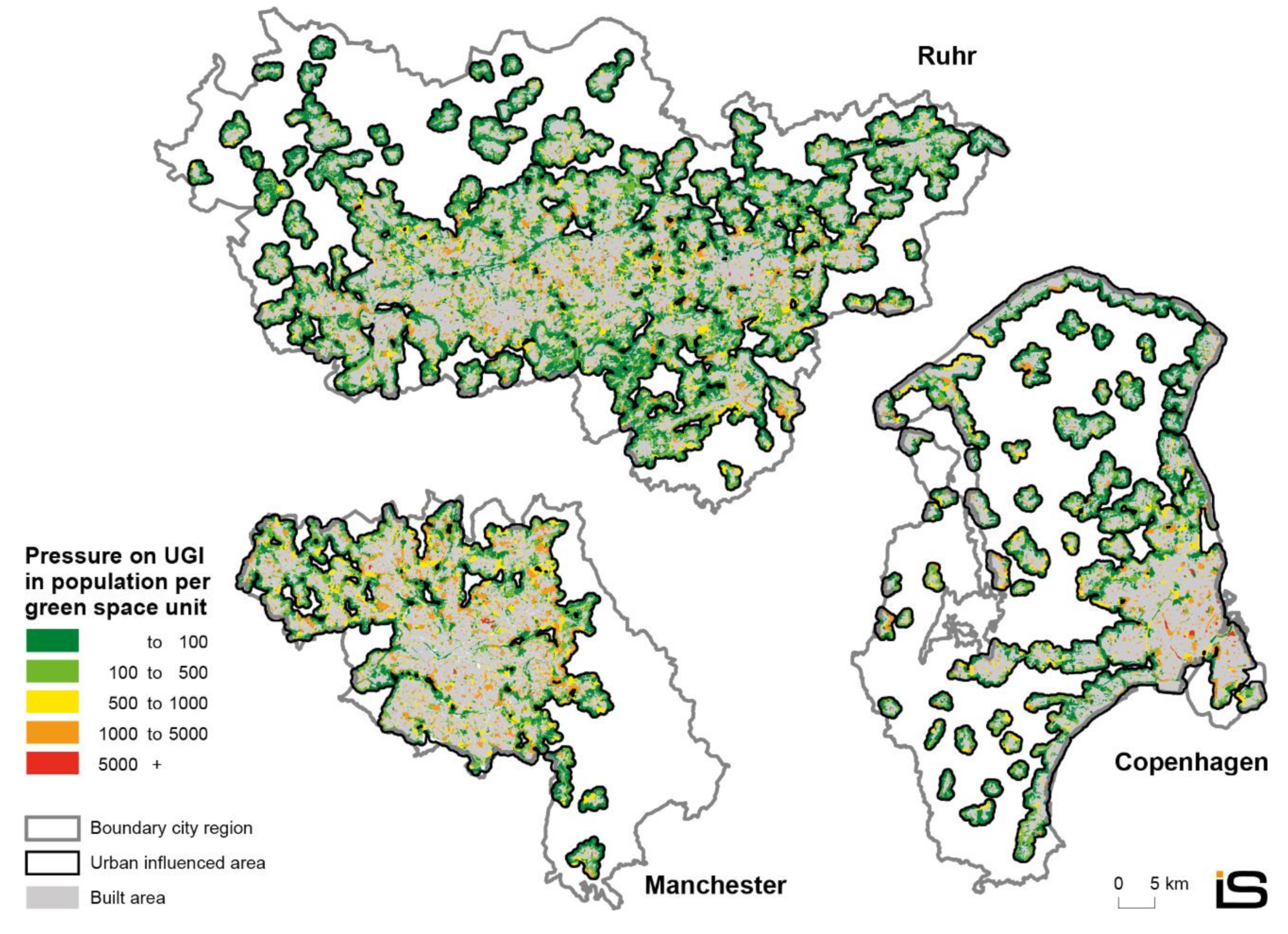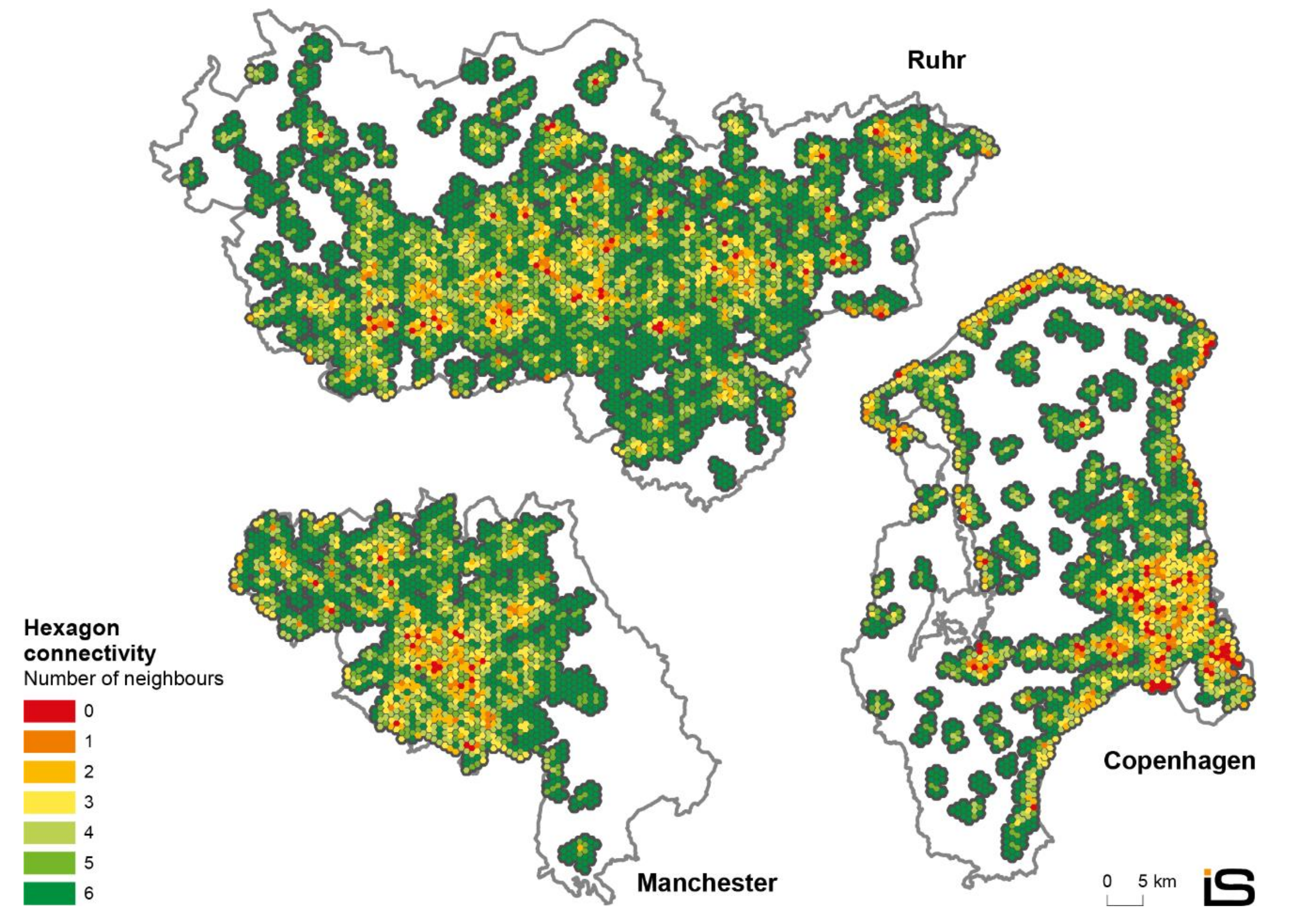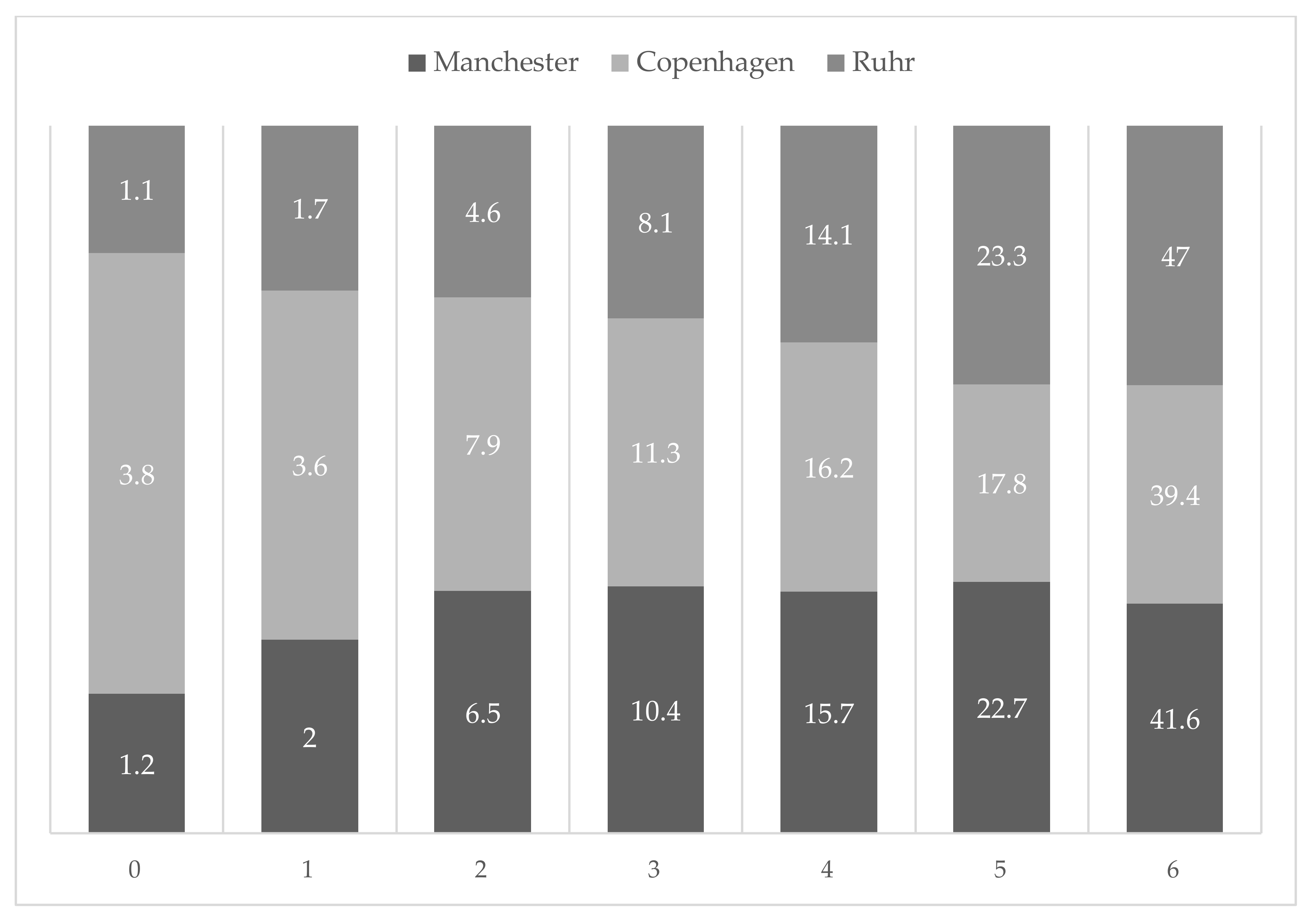Mapping and Assessing Green Infrastructure Connectivity in European City Regions
Abstract
:1. Introduction
2. Materials and Methods
- Isolation of green spaces—The first indicator is similar to standard distance measures used in multifunctionality analyses. In contrast, the focus is not on identifying where isolated settlement areas are situated within the urban realm, as is the case for the distance from any settlement area to the nearest green space [21]. In our case, the mapping logic starting point is each green space from which we calculate the distance to the nearest neighbouring green space. By doing so, our indicator highlights areas within urban influenced areas where green space supply is relatively scattered and isolated. More precisely, the isolation is centred around the spatial linkage of one element of green infrastructure to another. In the case of a green space that is far away from the nearest next green space, the indicator is high, and vice versa for plots in which green spaces directly connect to another.Isolation can, therefore, be seen as a spatially explicit version of the proximity metric used in landscape analysis [14]. The motivation is to inform spatial planning in cities and regions not only where settlement areas lack connectivity to green spaces but also to extend the view of UGI to understand where there is a lack of green space connectivity.
- Connectivity hexagons—The isolation analysis is further deepened by introducing a hexagon grid onto the spatial extension of the urban influenced area. Hexagon grids are very powerful when looking at cell connectivity because they outperform regular rectangular grids in terms of explaining neighbourhood connectivity levels. This is because they cover an entire area of interest but also give information on the number of neighbourhood connections while offering minimum distances between hexagon centres [33].In our UGI connectivity analysis, we construct a hexagon grid with 500-m sides for the three urban-influenced case study areas. For each grid cell, we set the dominating land use class as its cell type, green space or settlement area. For instance, a hexagon in which the dominant land use is commercial areas, will be defined as settlement area. In contrast to this there are green area hexagons, if the dominant land use (over 50% of the hexagon area) is of any of the UGI land use types.
3. Results
4. Discussion
5. Conclusions
Author Contributions
Funding
Acknowledgments
Conflicts of Interest
References
- Mell, I.C. Green infrastructure: Reflections on past, present and future praxis. Landsc. Res. 2017, 42, 135–145. [Google Scholar] [CrossRef]
- Fuller, R.A.; Gaston, K.J. The scaling of green space coverage in European cities. Biol. Lett. 2009, 5, 352–355. [Google Scholar] [CrossRef] [PubMed]
- Communication from the Commission to the European Parliament; The Council; The European Economic and Social Committee; The committee of the Regions. Green Infrastructure (GI)—Enhancing Europe’s Natural Capital. Available online: https://eur-lex.europa.eu/legal-content/EN/ALL/?uri=celex:52013DC0249 (accessed on 26 March 2019).
- Hansen, R.; Pauleit, S. From multifunctionality to multiple ecosystem services? A conceptual framework for multifunctionality in green infrastructure planning for urban areas. Ambio 2014, 43, 516–529. [Google Scholar] [CrossRef] [PubMed]
- Dige, G.; Liquete, C.; Kleeschulte, S.; Banko, G. Spatial Analysis of Green Infrastructure in Europe; Publications Office: Luxembourg, 2014. [Google Scholar]
- Grădinaru, S.R.; Hersperger, A.M. Green infrastructure in strategic spatial plans: Evidence from European urban regions. Urban For. Urban Green. 2018, 1–12. [Google Scholar] [CrossRef]
- Lennon, M.; Scott, M. Delivering ecosystems services via spatial planning: Reviewing the possibilities and implications of a green infrastructure approach. Town Plan. Rev. 2014, 85, 563–587. [Google Scholar] [CrossRef]
- Maes, J.; Barbosa, A.; Baranzelli, C.; Zulian, G.; Batista Silva, F.; Vandecasteele, I.; Hiederer, R.; Liquete, C.; Paracchini, M.L.; Mubareka, S.; et al. More green infrastructure is required to maintain ecosystem services under current trends in land-use change in Europe. Landsc. Ecol. 2015, 30, 517–534. [Google Scholar] [CrossRef] [PubMed]
- Demuzere, M.; Orru, K.; Heidrich, O.; Olazabal, E.; Geneletti, D.; Orru, H.; Bhave, A.G.; Mittal, N.; Feliu, E.; Faehnle, M. Mitigating and adapting to climate change: Multi-functional and multi-scale assessment of green urban infrastructure. J. Environ. Manag. 2014, 146, 107–115. [Google Scholar] [CrossRef]
- Voskamp, I.M.; van de Ven, F.H.M. Planning support system for climate adaptation: Composing effective sets of blue-green measures to reduce urban vulnerability to extreme weather events. Build. Environ. 2015, 83, 159–167. [Google Scholar] [CrossRef]
- Mell, I.; Allin, S.; Reimer, M.; Wilker, J. Strategic green infrastructure planning in Germany and the UK: A transnational evaluation of the evolution of urban greening policy and practice. Int. Plan. Stud. 2017, 22, 333–349. [Google Scholar] [CrossRef]
- Liquete, C.; Kleeschulte, S.; Dige, G.; Maes, J.; Grizzetti, B.; Olah, B.; Zulian, G. Mapping green infrastructure based on ecosystem services and ecological networks: A Pan-European case study. Environ. Sci. Policy 2015, 54, 268–280. [Google Scholar] [CrossRef]
- Lindholm, G. The implementation of green infrastructure: Relating a general concept to context and site. Sustainability 2017, 9, 610. [Google Scholar] [CrossRef]
- Lynch, A.J. Is it good to be green? Assessing the ecological results of county green infrastructure planning. J. Plan. Educ. Res. 2015, 36, 90–104. [Google Scholar] [CrossRef]
- Bartesaghi Koc, C.; Osmond, P.; Peters, A. Towards a comprehensive green infrastructure typology: A systematic review of approaches, methods and typologies. Urban Ecosyst. 2017, 20, 15–35. [Google Scholar] [CrossRef]
- Sartorio, F.S.; Thomas, H.; Harris, N. Interpreting planners’ talk about change: An exploratory study. Plan. Theory 2017, 17, 605–627. [Google Scholar] [CrossRef]
- Reimer, M. Planning cultures in transition: Sustainability management and institutional change in spatial planning. Sustainability 2013, 5, 4653–4673. [Google Scholar] [CrossRef]
- Othengrafen, F. The concept of planning culture: Analysing how planners construct practical judgements in a culturised context. Int. J. E Plan. Res. 2014, 3, 1–17. [Google Scholar] [CrossRef]
- Reimer, M.; Rusche, K. Green infrastructure under pressure. A global narrative between regional vision and local implementation. Eur. Plan. Stud. 2019. [Google Scholar] [CrossRef]
- Kabisch, N.; Strohbach, M.; Haase, D.; Kronenberg, J. Urban green space availability in European cities. Ecol. Indic. 2016, 70, 586–596. [Google Scholar] [CrossRef]
- Grunewald, K.; Richter, B.; Meinel, G.; Herold, H.; Syrbe, R.-U. Proposal of indicators regarding the provision and accessibility of green spaces for assessing the ecosystem service “recreation in the city” in Germany. Int. J. Biodivers. Sci. Ecosyst. Serv. Manag. 2017, 13, 26–39. [Google Scholar] [CrossRef]
- Newman, P.; Thornley, A. Urban Planning in Europe: International Competition, National Systems, and Planning Projects; Routledge: London, UK, 1996. [Google Scholar]
- Galland, D.; Sørensen, M.T. Daniel Galland, Michael Tophøj Sørensen—Denmark. DISP Plan. Rev. 2015, 51, 30–31. [Google Scholar] [CrossRef]
- Rusche, K. Ökonomischer Nutzen Grüner Infrastruktur: Mehr Lebensqualität durch Stadtgrün? Ber. Dtsch. Landeskd. 2012, 86, 255–268. [Google Scholar]
- Derkzen, M.L.; van Teeffelen, A.J.A.; Verburg, P.H.; Diamond, S. REVIEW: Quantifying urban ecosystem services based on high-resolution data of urban green space: An assessment for Rotterdam, The Netherlands. J. Appl. Ecol. 2015, 52, 1020–1032. [Google Scholar] [CrossRef]
- Eler, K.; Zeleznikar, S.; Cveji, R.; Pintar, M.; Haase, D.; Kabisch, N.; Strohbach, M.; Annerstedt van den Bosch, M.; Kowarik, I.; Fischer, L.K. Green Surge, Functional Linkages between Urban Green Infrastructure, Biodiversity and Human Well-Being; University of Copenhagen: Copenhagen, Denmark, 2016. Available online: https://greensurge.eu/working-packages/wp3/files/D3.2_final.pdf (accessed on 26 March 2019).
- Geoghegan, J.; Wainger, L.A.; Bockstael, N.E. Spatial landscape indices in a hedonic framework: An ecological economics analysis using GIS. Ecol. Econ. 1997, 23, 251–264. [Google Scholar] [CrossRef]
- Palmer, J.F. Using spatial metrics to predict scenic perception in a changing landscape: Dennis, Massachusetts. Landsc. Urban Plan. 2004, 69, 201–218. [Google Scholar] [CrossRef]
- Poelman, H. A Walk to the Park? Assessing Access to Green Areas in Europe’s Cities; European Commission: Brussels, Belgium, 2018. Available online: https://ec.europa.eu/regional_policy/sources/docgener/work/2018_01_green_urban_area.pdf (accessed on 26. March 2019).
- European Environment Agency. Spatial Analysis of Green Infrastructure in Europe; European Environment Agency: Copenhagen, Denmark, 2014. Available online: https://www.eea.europa.eu/publications/spatial-analysis-of-green-infrastructure (accessed on 26 March 2019).
- Tratalos, J.A.; Haines-Young, R.; Potschin, M.; Fish, R.; Church, A. Cultural ecosystem services in the UK: Lessons on designing indicators to inform management and policy. Ecol. Indic. 2016, 61, 63–73. [Google Scholar] [CrossRef]
- Handley, J.; Pauleit, S.; Slinn, P.; Barber, A.; Baker, M.; Jones, C.; Lindley, S. Accessible Natural Green Space Standards in Towns and Cities, A Review and Toolkit for Their Implementation; English Nature: Manchester, UK, 2013. Available online: publications.naturalengland.org.uk/file/78003 (accessed on 26 March 2019).
- Birch, C.P.D.; Oom, S.P.; Beecham, J.A. Rectangular and hexagonal grids used for observation, experiment and simulation in ecology. Ecol. Model. 2007, 206, 347–359. [Google Scholar] [CrossRef]
- Duvall, P.; Lennon, M.; Scott, M. The ‘natures’ of planning: Evolving conceptualizations of nature as expressed in urban planning theory and practice. Eur. Plan. Stud. 2017, 26, 480–501. [Google Scholar] [CrossRef]
- Maragno, D.; Gaglio, M.; Robbi, M.; Appiotti, F.; Fano, E.A.; Gissi, E. Fine-scale analysis of urban flooding reduction from green infrastructure: An ecosystem services approach for the management of water flows. Ecol. Model. 2018, 386, 1–10. [Google Scholar] [CrossRef]
- Di Marino, M.; Lapintie, K. Exploring the concept of green infrastructure in urban landscape. Experiences from Italy, Canada and Finland. Landsc. Res. 2017, 43, 139–149. [Google Scholar] [CrossRef]
- Syrbe, R.-U.; Walz, U. Spatial indicators for the assessment of ecosystem services: Providing, benefiting and connecting areas and landscape metrics. Ecol. Indic. 2012, 21, 80–88. [Google Scholar] [CrossRef]
- Baró, F.; Haase, D.; Gómez-Baggethun, E.; Frantzeskaki, N. Mismatches between ecosystem services supply and demand in urban areas: A quantitative assessment in five European cities. Ecol. Indic. 2015, 55, 146–158. [Google Scholar] [CrossRef]
- Burkhard, B.; Kroll, F.; Nedkov, S.; Müller, F. Mapping ecosystem service supply, demand and budgets. Ecol. Indic. 2012, 21, 17–29. [Google Scholar] [CrossRef]
- Anselin, L.; Rey, S.J. Modern Spatial Econometrics in Practice: A Guide to GeoDa, GeoDaSpace and PySAL; GeoDa Press: Chicago, IL, USA, 2014. [Google Scholar]





| Elements of Green Infrastructure | |
|---|---|
| 14,100 | Green urban areas |
| 14,200 | Sports and leisure facilities |
| 21,000 | Arable land (annual crops) |
| 22,000 | Permanent crops (vineyards, fruit trees, olive groves) |
| 23,000 | Pastures |
| 24,000 | Complex and mixed cultivation patterns |
| 25,000 | Orchards at the fringe of urban classes |
| 31,000 | Forests |
| 32,000 | Herbaceous vegetation associations (natural grassland, moors, etc.) |
| 33,000 | Open spaces with little or no vegetation |
| 40,000 | Wetland |
| 50,000 | Water bodies |
© 2019 by the authors. Licensee MDPI, Basel, Switzerland. This article is an open access article distributed under the terms and conditions of the Creative Commons Attribution (CC BY) license (http://creativecommons.org/licenses/by/4.0/).
Share and Cite
Rusche, K.; Reimer, M.; Stichmann, R. Mapping and Assessing Green Infrastructure Connectivity in European City Regions. Sustainability 2019, 11, 1819. https://0-doi-org.brum.beds.ac.uk/10.3390/su11061819
Rusche K, Reimer M, Stichmann R. Mapping and Assessing Green Infrastructure Connectivity in European City Regions. Sustainability. 2019; 11(6):1819. https://0-doi-org.brum.beds.ac.uk/10.3390/su11061819
Chicago/Turabian StyleRusche, Karsten, Mario Reimer, and Rico Stichmann. 2019. "Mapping and Assessing Green Infrastructure Connectivity in European City Regions" Sustainability 11, no. 6: 1819. https://0-doi-org.brum.beds.ac.uk/10.3390/su11061819





